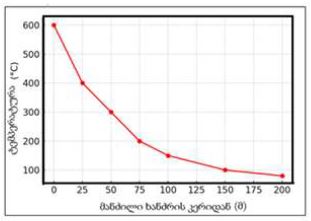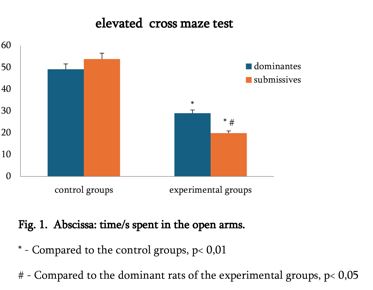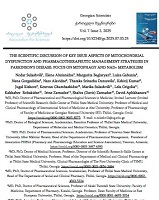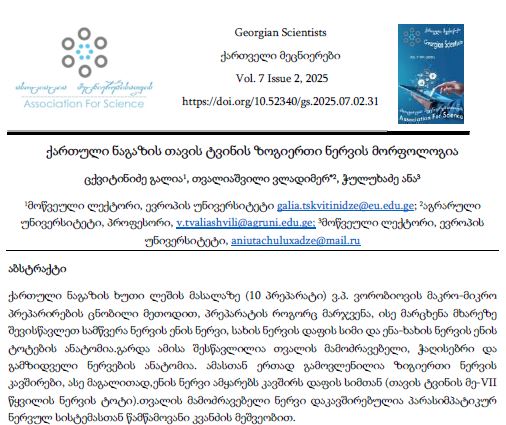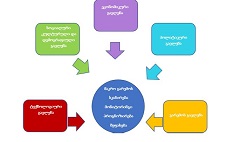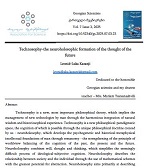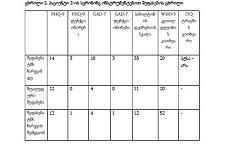საქართველოში კულტივრებული Rosa x damascena-ს ეთერზეთის წარმოებით მიღებული ნარჩენი წყლიანი ფრაქციების ფარმაკოლოგიური პოტენციალი.
ჩამოტვირთვები
დამატებითი ფაილები
დამასკოს ვარდი (Rosa x damascena Herrm) გვარი Rosa L.-ის ცნობილი სახეობაა, რომელიც ფართოდაა გავრცელებული მრავალ ქვეყანაში მისი დეკორატიული თვისებების და განსაკუთრებით ძვირფასი ეთერზეთის შემცველობის გამო. ეს უკანასკნელი საუკუნეების მანძილზე გამოიყენებოდა ხალხურ მედიცინაში, პარფიუმერიაში, კოსმეტოლოგიაში, არომათერაპიაში. დამასკოს ვარდზე ჩატარებული სამეცნიერო კვლევის შედეგები იძლევა პერსპექტიულ ინფორმაციას მის მრავალფეროვან ფარმაკოლოგიურ ეფექტებსა და სამკურნალო მიზნით გამოყენებაზე. თუმცა, უნდა აღინიშნოს, რომ ამ დასკვნების დასადასტურებლად სიღმისეული კვლევებია საჭირო რათა დადგინდეს ბიოლოგიურად აქტიური ნაერთების მოქმედების მექანიზმები. კვლევა მიზნად ისახავდა საქართველოში კულტივრებული R. damascena-დან ვარდის ეთერზეთის წარმოების დროს მიღებული ნარჩენი წყლიანი ექსტრაქტის სხვადასხვა პოლარობის ფრაქციების RDF-H2O, RDF-50% და RDF-100% ფარმაკოლოგიური პოტენციალის შეფასებას in vivo ექსპერიმენტში. კარაგენანით გამოწვეული მწვავე ანთების მოდელში მღრღნელებში დადგინდა, რომ სამივე ფრაქციას - RDF-H2O, RDF-50% და RDF-100% აქვს საშუალოზე მაღალი სიძლიერის ანთების საწინააღმდეგო ეფექტი. მათ შორის, RDF-50% იყო მნიშვნელოვნად უფრო აქტიური და გამოიწვია შეშუპების 62.5% დათრგუნვა. თაგვებში "ცხელი ფირფიტის" ტესტში ანალგეზიური თვისებების შეფასებისას, ფრაქციებმა RDF-50% და RDF-100% გამოავლინეს ყველაზე ძლიერი ტკივილგამაყუჩებელი ეფექტი, მაქსიმუმით (86.0 და 99.7%, შესაბამისად) მიღებიდან 1 საათის შემდეგ. მღრღნელებში აბსოლუტური ეთანოლით გამოწვეული კუჭის წყლულის მოდელზე გამოვლინდა, რომ ფრაქციებს RDF-H2O და RDF-100% აქვთ საშუალო სიძლიერის გასტროპროტექტორული ეფექტი (48 და 40%, შესაბამისად), ხოლო RDF-50% ნაკლებად ეფექტური აღმოჩნდა. მიღებული შედეგები ხაზს უსვამს ფიტოქიმიური კვლევების სამომავლო პერსპექტიულობას, რათა დადგინდეს ზემოაღნიშნულ ფრაქციებში ფარმაკოლოგიურ ეფექტებზე პასუხისმგებელი ინდივიდუალური ნაერთები.
Downloads
Adinortey MB, Ansah C, Galyuon I, Nyarko A. (2013). In Vivo Models Used for Evaluation of Potential Antigastroduodenal Ulcer Agents. Ulcers.
Akram M, Riaz M, Munir N, et al. (2019) Chemical constituents, experimental and clinical pharmacology of Rosa damascena: a literature review. J Pharm Pharmacol. 2020 Feb;72(2):161-174. https://doi.org/10.1111/jphp.13185
Basim E, Basim H (2003) Antibacterial activity of Rosa damascena essential oil. Fitoterapia. 74(4), 394-6.
Baydar NG, Baydar H (2013) Phenolic compounds, antiradical activity and antioxidant capacity of oil-bearing rose (Rosa damascena Mill.) extracts. Ind Crops Products 41:375–380. https://doi.org/10.1016/j.indcrop.2012.04.045
Boskabady MH, Shafei MN, Saberi Z, Amini S. Pharmacological effects of rosa damascena. Iran J Basic Med Sci. 2011 Jul;14(4):295-307. . 499.
Dina E, Sklirou AD, Chatzigeorgiou S, et al. (2021). An enriched polyphenolic extract obtained from the by-product of Rosa damascena hydrodistillation activates antioxidant and proteostatic modules. Phytomedicine. 93:153757. https://doi.org/10.1016/j.phymed.2021.153757
Directive 2010/63/EU of the European Parliament and of the Council of 22 September 2010 on the protection of animals used for scientific purposes. Official Journal of the European Union. L 276/33-79
Dossi CG , González-Mañán D , Romero N et al (2018). Anti-oxidative and anti-inflammatory effects of Rosa Mosqueta oil supplementation in rat liver ischemia-reperfusion. Food Funct. 9(9): 4847-4857. https://doi.org/10.1039/c8fo00969d
Erbas S., Baydar H. (2016). Variation in scent compounds of oil bearing Rose (Rose damascena Mill.) produced by Headspace Solid Phase Microextraction, hydrodistillation and solvent extraction, Academy of Chemistry of Globe publications Rec. Nat. Prod. 10:5, 555-565.
Farooq A, Khan M, Riaz A., Ali A. (2011). Diversity of morphology and oil content of Rosa damascena landraces and related Rosa species from Pakistan. Pakistan Journal of Agricultural Sciences 48(3), 177-183.
Galal TM, Al-Yasi HM, Fawzy MA et al. Evaluation of the Phytochemical and Pharmacological Potential of Taif’s Rose (Rosa damascena Mill var. trigintipetala) for Possible Recycling of Pruning Wastes. Life. 2022; 12(2):273. https://doi.org/10.3390/life12020273
Hajhashemi,V, Ghannadi A, Hajilooa M (2010) Analgesic and Anti-inflammatory Effects of Rosa damascena Hydroalcoholic Extract and its Essential Oil in Animal Models. Iran J Pharm Res. 9(2): 163–168.
Homayoun M., Shafieian, R., Seghatoleslam M. et.al (2020). Protective impact of Rosa damascena against neural damage in a rat model of pentylenetetrazole (PTZ)-induced seizure. Avicenna Journal of Phytomedicine, 10, 574 - 583. https://doi.org/10.22038/AJP.2020.15621
Kalcheva-Karadzhova K, Shikov V, Mihalev K, et al. (2014) Enzyme-assisted extraction of polyphenols from rose (Rosa damascena Mill.) petals. Acta Univ Cib Ser E Food Technol 18(2):65–72. https://doi.org/10.2478/aucft-2014-0015
Kumar N, Singh B, Kaul V (2006) Flavonoids from Rosa damascena Mill. Natural Product Communications, 1(8); 623-626. https://doi.org/10.1177/1934578X0600100805
Labban L. and Thallaj N. (2020). The medicinal and pharmacological properties of Damascene Rose (Rosa damascena): A review. International Journal of Herbal Medicine 8(2), 33-37.
Latifi, G., Ghannadi, A., Minaiyan, M. (2015). Anti-inflammatory effect of volatile oil and hydroalcoholic extract of Rosa damascena Mill. on acetic acid-induced colitis in rats. Research in pharmaceutical sciences, 10(6), 514–522.
Mahboubi M. Rosa damascena as holy ancient herb with novel applications. Journal of Traditional and Complementary Medicine 6 (2016) 10-16 http://dx.doi.org/10.1016/j.jtcme.2015.09.005
McDonald JH. Handbook of Biological Statistics, 3rd ed. Baltimore, Sparky House Publishing. 2014.
Memariani Z. et al. (2015) Comparative analysis of phenolic compounds in two samples of Rosa damascena by HPLC. International Journal of Biosciences. 7(1), 112-118. http://dx.doi.org/10.12692/ijb/7.1.112-118
Morris C.J. (2003) Carrageenan-Induced Paw Edema in the Rat and Mouse. Methods in Molecular Biology, vol. 225: Inflammation Protocols 115-122.
Mulkijanyan K, Gogitidze N, Sulakvelidze M, et al. Pharmacological assessment of the aqueous extract of rose oil waste from Rosa x damascena Herrm cultivated in Georgia. World Journal of Biology Pharmacy and Health Sciences, 2021, 07(01), 001–008. https://doi.org/10.30574/wjbphs.2021.7.1.0069
Ng T.B., He J.S., Nius S.M., et al. (2004) A gallic acid derivate and polysaccharides with antioxidative activity from rose (Rosa rugosa) flowers. J Pharm Pharmacol 56(4):537–545. https://doi.org/10.1211/0022357022944
Olech M, Nowak R, Nowacka N, Pecio Ł, Oleszek W, Los R, Malm A, Rzymowska J (2015) Evaluation of rose roots, a post-harvest plantation residue as a source of phytochemicals with radical scavenging, cytotoxic, and antimicrobial activity. Ind Crops Prod 69:129–136. https://doi.org/10.1016/j.indcrop.2015.02.017
Ozkan G, Sagdic O, Baydar NG, Baydar H (2004) Antioxidant and anti-bacterial activities of R. damascena flower extracts. Food Sci Technol Int 10:277–281. https://doi.org/10.1177/1082013204045882
Parle M. et al. (2013) Laboratory models for screening analgesics. International Research Journal of Pharmacy, 4(1), 15-19.
Pavlov A, Popov S, Kovacheva E; Georgiev M, Ilieva M (2005). Volatile and polar compounds in R. damascena Mill 1803 cell suspension. , 118(1), 89–97. doi: 10.1016/j.jbiotec.2005.03.005
Rakhshandah H, Shakeri MT, Ghasemzadeh MR. (2007) Comparative Hypnotic Effect of Rosa damascena Fractions and Diazepam in Mice. Iranian Journal of Pharmaceutical Research, 6 (3): 193-197. https://dx.doi.org/10.22037/ijpr.2010.721
Rezvani-Kamran, A., Salehi, I., Shahidi, S. et al. (2017). Effects of the hydroalcoholic extract of Rosa damascena on learning and memory in male rats consuming a high-fat diet. Pharmaceutical Biology, 55, 2065 - 2073. https://doi.org/10.1080/13880209.2017.1362010
Sabahi Z. et al (2020), Valorization of Waste Water of Rosa damascena Oil Distillation Process by Ion Exchange Chromatography. The Scientific World Journal, vol. 2020, Article ID 5409493, 6 pg. https://doi.org/10.1155/2020/5409493
Slavov A., Vasileva I., Stefanov L. et al. (2017). Valorization of wastes from the rose oil industry. Rev Environ Sci Biotechnol 16, 309–325. https://doi.org/10.1007/s11157-017-9430-5
The Plant List (TPL) http://www.theplantlist.org/
Wen-ya Liu, Lin-yu Chen, Ying-ying Huang et al. (2020) Antioxidation and active constituents analysis of flower residue of Rosa damascena. Chinese Herbal Medicines, 12(3), 336-341. https://doi.org/10.1016/j.chmed.2020.05.005
World Flora Online (WFO) http://www.worldfloraonline.org/
Yousefi B., Jaimand K. (2018) Chemical Variation in the Essential Oil of Iranian Rosa damascena Landraces under Semi-arid and Cool Conditions. International Journal of Horticultural Science and Technology 5(1); 81-92. https://doi.org/10.22059/ijhst.2018.256329.234
საავტორო უფლებები (c) 2023 ქართველი მეცნიერები

ეს ნამუშევარი ლიცენზირებულია Creative Commons Attribution-NonCommercial-NoDerivatives 4.0 საერთაშორისო ლიცენზიით .





























































